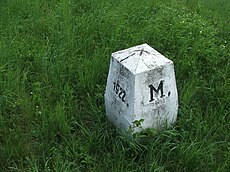Hungary–Romania border: Difference between revisions
Enthusiast01 (talk | contribs) No edit summary |
Enthusiast01 (talk | contribs) No edit summary |
||
| Line 18: | Line 18: | ||
}} |
}} |
||
[[File:Hungary-Romania Boundery.jpg|280px|thumb|right]] |
[[File:Hungary-Romania Boundery.jpg|280px|thumb|right]] |
||
The '''Hungary–Romania border''' is the state border between [[Hungary]] and [[Romania]]. It was established in 1920 by an international commission (the "Lord Commission") presided over by geographers including [[Emmanuel de Martonne]] and [[Robert Ficheux]],<ref>[http://www.radioiasi.ro/stiri/supliment/in-memoriam-robert-ficheux-francezul-care-a-iubit-cu-o-fidelitate-neasemuita-romania/ In Memoriam Robert Ficheux, francezul care a iubit, cu o fidelitate neasemuită, România]</ref> and historians [[Robert William Seton-Watson]] and [[Ernest Denis]].<ref>Lowczyk Olivier, ''La fabrique de la paix. Du Comité d'études à la Conférence de la paix, l'élaboration par la France des traités de la Première Guerre mondiale'', Paris, Economica, Coll. Bibliothèque stratégique, 2010, 533p.</ref> The border |
The '''Hungary–Romania border''' is the state border between [[Hungary]] and [[Romania]]. It was established in 1920 by an international commission (the "Lord Commission") presided over by geographers including [[Emmanuel de Martonne]] and [[Robert Ficheux]],<ref>[http://www.radioiasi.ro/stiri/supliment/in-memoriam-robert-ficheux-francezul-care-a-iubit-cu-o-fidelitate-neasemuita-romania/ In Memoriam Robert Ficheux, francezul care a iubit, cu o fidelitate neasemuită, România]</ref> and historians [[Robert William Seton-Watson]] and [[Ernest Denis]].<ref>Lowczyk Olivier, ''La fabrique de la paix. Du Comité d'études à la Conférence de la paix, l'élaboration par la France des traités de la Première Guerre mondiale'', Paris, Economica, Coll. Bibliothèque stratégique, 2010, 533p.</ref> The border was formalised by the [[Treaty of Trianon]] which was signed on 4 June 1920. |
||
The border is {{convert|448|km|mi|abbr=on}} long, demarcated by pillars and approximately {{convert|20|km|mi|abbr=on}} of the [[Maros River]]. There are no known disputes. |
The border is {{convert|448|km|mi|abbr=on}} long, demarcated by pillars and approximately {{convert|20|km|mi|abbr=on}} of the [[Maros River]]. There are no known disputes. |
||
The Hungary–Romania border is an internal border of the [[European Union]]. However, as of {{currentyear}}, Romania is not a part of the [[Schengen Area]]. |
|||
==Geography== |
==Geography== |
||
Revision as of 09:23, 23 April 2019
| Hungary–Romania border | |
|---|---|
 Border marker between Hungary and Romania at Csenger | |
| Characteristics | |
| Entities | |
| Length | 448 km (278 mi) |
| History | |
| Established | 1920 Signing of the Treaty of Trianon at the end of the World War I |
| Current shape | 1947 Paris Peace Treaties |
| Treaties | Treaty of Trianon (1920) Second Vienna Award (1940) Paris Peace Treaties (1947) |

The Hungary–Romania border is the state border between Hungary and Romania. It was established in 1920 by an international commission (the "Lord Commission") presided over by geographers including Emmanuel de Martonne and Robert Ficheux,[1] and historians Robert William Seton-Watson and Ernest Denis.[2] The border was formalised by the Treaty of Trianon which was signed on 4 June 1920.
The border is 448 km (278 mi) long, demarcated by pillars and approximately 20 km (12 mi) of the Maros River. There are no known disputes.
The Hungary–Romania border is an internal border of the European Union. However, as of 2024, Romania is not a part of the Schengen Area.
Geography
The Hungarian–Romanian border begins at a tripoint located in the historical region of the Banat, 15 km (9.3 mi) south-east of the Hungarian town of Szeged, where the border between Hungary and Serbia intersects the land border between Romania and Serbia. It generally runs south-south-westwards/north-north-eastwards across the Pannonian Basin to another tripoint located on the Tur river, 16 km (9.9 mi) north of the Romanian town of Satu Mare, where the Hungarian-Ukrainian border intersects the land border between Romania and Ukraine.
Border crossings
Road
- Cenad - Kiszombor
- Nădlac - Nagylak
- Nădlac - Nagylak Motorway
- Turnu - Battonya
- Vărșand - Gyula
- Salonta - Méhkerék
- Borș - Ártánd
- Săcuieni - Létavértes
- Valea lui Mihai - Nyírábrány
- Urziceni - Vállaj
- Petea - Csengersima
Rail
All railway crossings are standard gauge. As of June 2018, all railway crossings have passenger traffic.
- Curtici - Lőkösháza, electrified 25 kV 50 Hz
- Salonta - Kötegyán
- Episcopia Bihor - Biharkeresztes
- Valea lui Mihai - Nyírábrány
- Carei - Tiborszállás
See also
References
- ^ In Memoriam Robert Ficheux, francezul care a iubit, cu o fidelitate neasemuită, România
- ^ Lowczyk Olivier, La fabrique de la paix. Du Comité d'études à la Conférence de la paix, l'élaboration par la France des traités de la Première Guerre mondiale, Paris, Economica, Coll. Bibliothèque stratégique, 2010, 533p.
